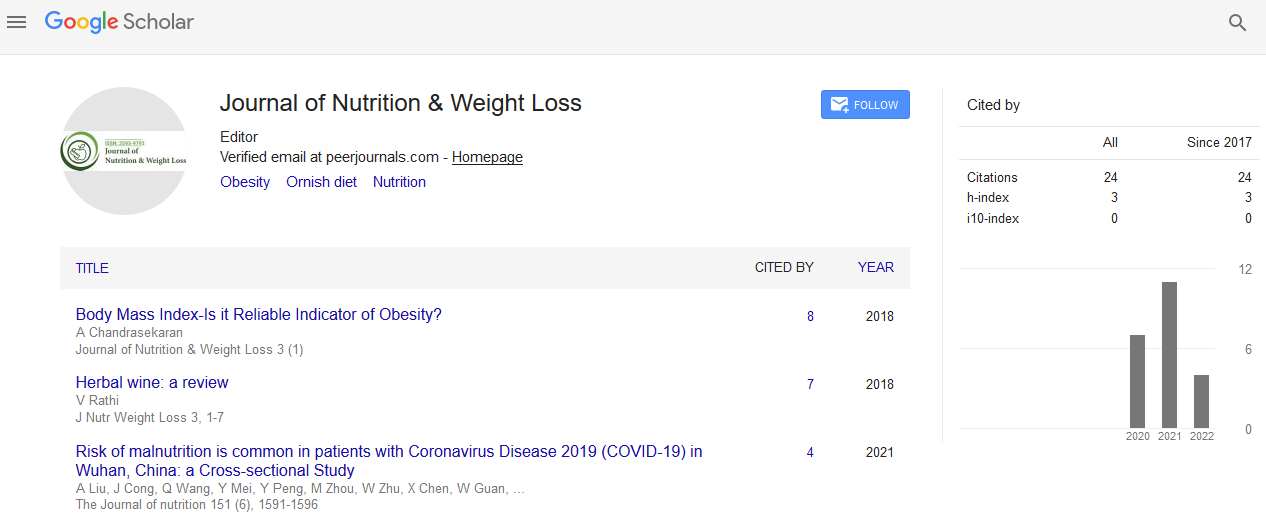Indexed In
- RefSeek
- Hamdard University
- EBSCO A-Z
- Publons
- Euro Pub
- Google Scholar
Useful Links
Share This Page
Journal Flyer

Open Access Journals
- Agri and Aquaculture
- Biochemistry
- Bioinformatics & Systems Biology
- Business & Management
- Chemistry
- Clinical Sciences
- Engineering
- Food & Nutrition
- General Science
- Genetics & Molecular Biology
- Immunology & Microbiology
- Medical Sciences
- Neuroscience & Psychology
- Nursing & Health Care
- Pharmaceutical Sciences
Opinion Article - (2025) Volume 10, Issue 2
Cultural Influences on Nutrition and Weight Loss Practices
Ahmed Al-Sayed*Received: 30-May-2025, Manuscript No. JNWL-25-29889; Editor assigned: 02-Jun-2025, Pre QC No. JNWL-25-29889 (PQ); Reviewed: 16-Jun-2025, QC No. JNWL-25-29889; Revised: 23-Jun-2025, Manuscript No. JNWL-25-29889 (R); Published: 30-Jun-2025, DOI: 10.35248/2593-9793.25.10.237
Description
Culture profoundly shapes the way individuals perceive food, nutrition, and weight loss. From the types of foods consumed to the rituals surrounding meals, cultural influences determine not only dietary choices but also attitudes toward body image and health. Understanding these influences is critical for designing effective nutritional interventions that respect cultural traditions while promoting healthier outcomes. Weight loss practices are not universally applicable, and strategies that ignore cultural contexts often fail in adherence and sustainability.
Dietary traditions vary widely across cultures, reflecting historical availability of foods, religious practices, and environmental conditions. In Mediterranean societies, diets rich in olive oil, vegetables, legumes, and fish have evolved not only due to agricultural conditions but also cultural appreciation of shared meals and moderation. In contrast, East Asian diets historically emphasized rice, soy products, fish, and vegetables, leading to lower rates of obesity compared to Western nations. However, globalization has increasingly homogenized food environments, introducing processed foods and sugary beverages into regions where they were once uncommon. This cultural shift has been accompanied by rising obesity rates worldwide.
Religious practices also influence eating behaviors. For example, fasting traditions in Islam, Christianity, and Hinduism affect meal timing, food choices, and overall caloric intake. Ramadan fasting, while spiritually significant, alters eating patterns and may lead to weight fluctuations depending on the foods consumed during non-fasting hours. Cultural adaptations that emphasize nutrient-dense foods during such practices can mitigate potential negative impacts on weight.
Body image ideals, shaped by cultural values, further influence weight loss practices. In some cultures, a fuller body is traditionally associated with prosperity, fertility, or attractiveness, while in others, thinness is idealized. These perceptions drive the motivation for weight loss and the acceptance of certain practices. For example, in Western societies, the emphasis on thinness has fueled the popularity of restrictive diets, while in regions where larger body size is socially desirable, weight loss efforts may face resistance. Public health interventions must navigate these cultural nuances to avoid stigmatization and ensure effectiveness.
Social structures also shape meal patterns. In collectivist cultures, meals are often shared, and food is central to community and family interactions. Refusing certain foods may be seen as disrespectful, complicating individual weight loss efforts. Strategies that integrate healthier cooking methods into traditional dishes, rather than promoting entirely foreign diets, are more likely to succeed. For instance, substituting refined grains with whole grains or reducing oil in traditional recipes preserves cultural identity while enhancing health.
Migration and acculturation introduce additional complexities. Immigrants often experience dietary transitions when adapting to new environments, sometimes adopting less healthy eating habits due to affordability, convenience, or cultural assimilation. Studies show that immigrant populations often experience rising obesity rates over time in their host countries, reflecting the adoption of Westernized diets. Tailored interventions that respect cultural preferences while promoting healthier substitutions can help mitigate these risks.
Public health messaging must also account for cultural communication styles. Visual campaigns, language use, and role models influence how messages are received. In some cultures, authority figures such as doctors or community leaders carry significant weight, while in others, peer networks or media celebrities play stronger roles. Adapting educational campaigns to resonate culturally increases their impact.
Globalization has also created opportunities for cultural exchange in nutrition. Superfoods, once limited to specific regions, are now marketed worldwide. While this expands dietary diversity, it also risks commercialization and loss of cultural context. For example, quinoa, once a staple of Andean diets, has become a global health food, raising concerns about sustainability and accessibility for local populations. Recognizing these dynamics is vital for equitable nutrition practices.
In conclusion, cultural influences on nutrition and weight loss practices are profound and multifaceted. Successful interventions must respect traditions, adapt to cultural values, and promote gradual, sustainable changes. By acknowledging the role of religion, body image, social norms, and globalization, nutrition science can bridge cultural divides and foster healthier societies without undermining cultural identity.
Citation: Al-Sayed A (2025). Cultural Influences on Nutrition and Weight Loss Practices. J Nutr Weight Loss. 10:237.
Copyright: © 2025 Al-Sayed A. This is an open access article distributed under the terms of the Creative Commons Attribution License, which permits unrestricted use, distribution, and reproduction in any medium, provided the original author and source are credited.


